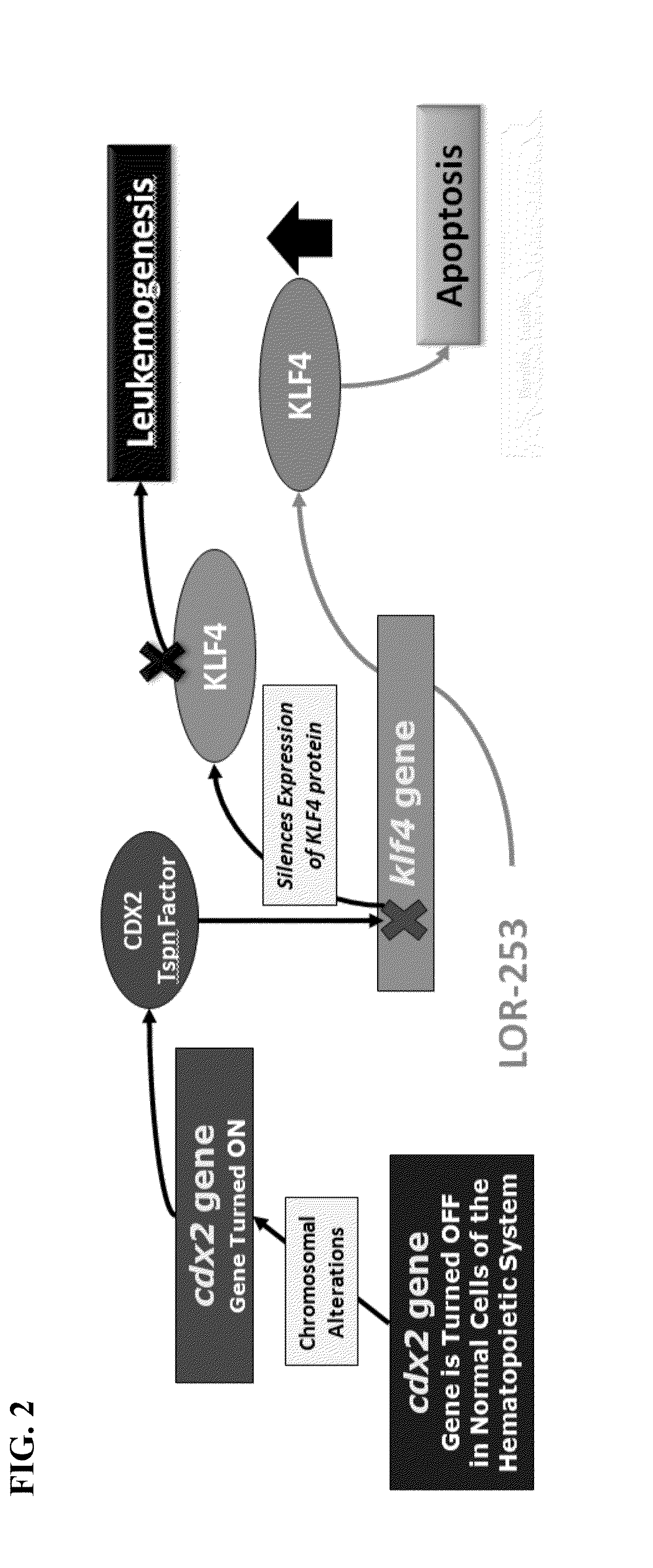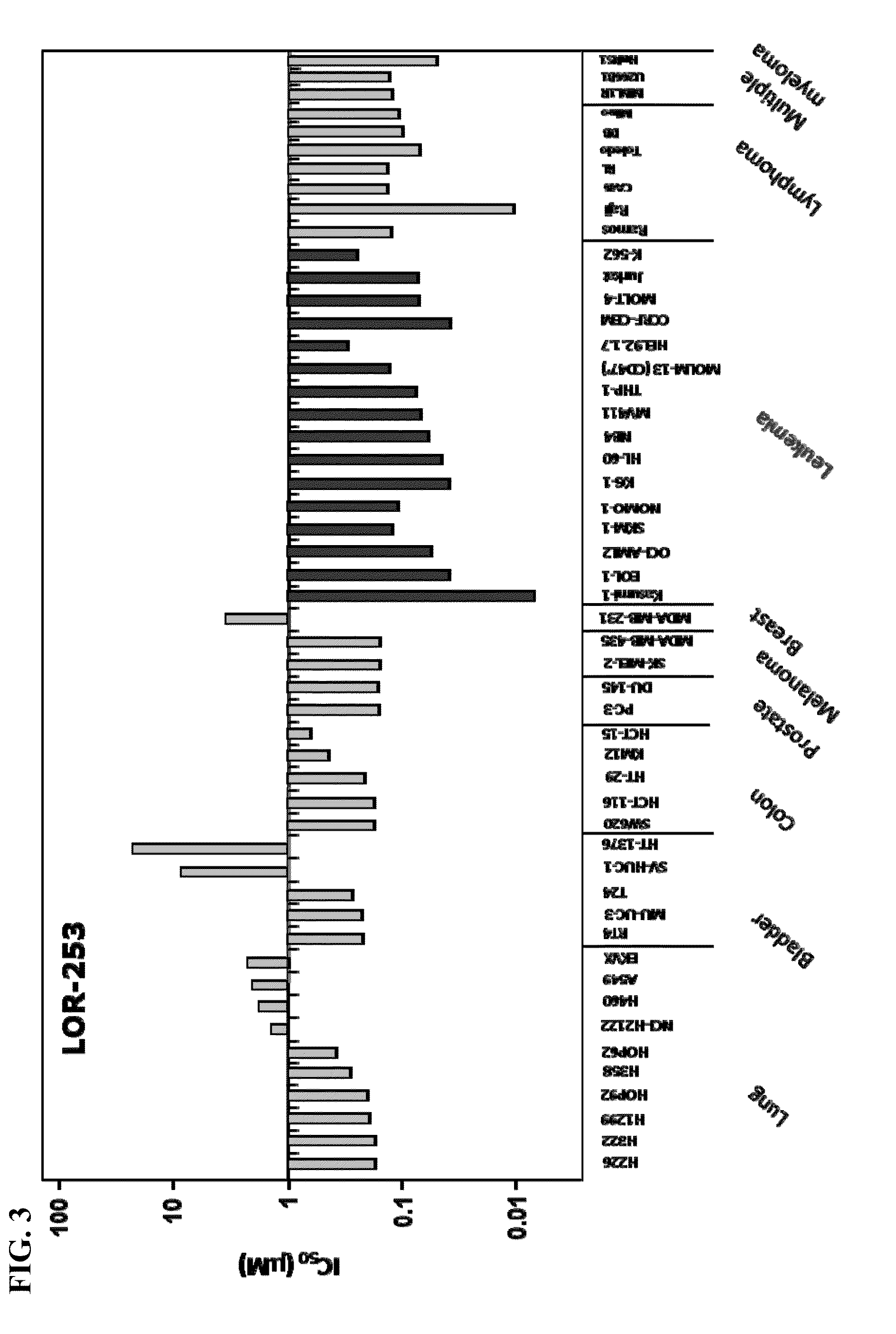Compositions and methods for treating cancers
a technology for cancer and compositions, applied in the field of compositions and methods for treating cancer, can solve the problems of severe and life-threatening, rare occurrence of myelodysplastic syndrome (mds), and ineffective current treatment for many cancers, so as to prevent or reduce the severity of a future occurrence of cancer, and inhibit the proliferation of cancer cells
- Summary
- Abstract
- Description
- Claims
- Application Information
AI Technical Summary
Benefits of technology
Problems solved by technology
Method used
Image
Examples
example 1
In Vitro Antiproliferative Activity of LOR-253 in Leukemia, Lymphoma and Multiple Myeloma Cell Lines
[0230]Antiproliferative activity of LOR-253 was determined by XTT assay as follows. Cells (4×103 / well) in 100 μL of growth medium were seeded in 96-well cell culture plates and incubated overnight at 37° C. The medium was removed and replaced with a total volume of 100 μL growth medium containing LOR-253 (or 0.1% DMSO vehicle control), as described in the respective experiments. Suspension cells were plated (4-6×103 / well) in 50 μL growth medium, and 50 μL growth medium containing LOR-253 (or 0.1% DMSO vehicle control) was added to each well. After incubation of the cells at 37° C. for 5 days, cell viability was quantitated with the use of sodium 3′-[1-(phenylamino-carbonyl)-3,4-tetrazolium}-bis(4-methoxy-6-nitro)benzene sulfonic acid hydrate (XTT) colorimetric assay (Roche). XTT labeling reagent (1 mg / mL) was mixed with electron-coupling reagent, following the manufacturer's instructi...
example 2
KLF4 / p21 Induction in AML Cell Lines In Vitro
[0232]To determine if KLF4 and / or p21 expressions are induced by LOR-253, AML cells (THP1, HL-60) were treated with DMSO (vehicle control) or 0.5 μM LOR-253 for 16 hours. Total RNA was extracted using the TRIzol Plus RNA Purification kit (Ambion, Life Technologies), according to the manufacturer's instructions. First strand cDNA was synthesized from 1-2 ug total RNA using random hexamer primers (Invitrogen) and the SuperScript II Reverse Transcriptase kit (Invitrogen). Quantitative RT-PCR was performed in the ABI Prism 7000 Sequence Detection System using cDNAs and human TaqMan Gene Expression Assay primer / probe sets for Kruppel-like factor 4 (KLF4), cyclin-dependent kinase inhibitor 1A (p21) and the ABI TaqMan Universal PCR master mix protocol. Gene expression was normalized with β-actin gene expression in the same sample, and fold changes in KLF4 or p21 were expressed relative to the corresponding expression level in the DMSO treated sa...
example 3
Treatment with LOR-253 Results in G1 / S Cell Cycle Arrest in AML Cell Lines
[0233]THP1 and HL-60 AML cell lines were treated with DMSO (vehicle control) or 0.5 μM LOR-253 for 16 hours. Cells were washed once in PBS+1% FCS and fixed using ice cold 70% ethanol overnight. Fixed cells were washed twice, resuspended in PI / RNaseA solution, containing 20 μg / mL propidium iodide and 250 μg / mL RNaseA, and stained for 30 minuets at 37° C. Stained cells were analyzed using a BD FACSCalibur flow cytometer. The results indicate treatment with LOR-253 results in G1 / S cell cycle arrest in AML cell lines (FIG. 5)
PUM
| Property | Measurement | Unit |
|---|---|---|
| pH | aaaaa | aaaaa |
| concentration | aaaaa | aaaaa |
| concentration | aaaaa | aaaaa |
Abstract
Description
Claims
Application Information
 Login to View More
Login to View More - R&D
- Intellectual Property
- Life Sciences
- Materials
- Tech Scout
- Unparalleled Data Quality
- Higher Quality Content
- 60% Fewer Hallucinations
Browse by: Latest US Patents, China's latest patents, Technical Efficacy Thesaurus, Application Domain, Technology Topic, Popular Technical Reports.
© 2025 PatSnap. All rights reserved.Legal|Privacy policy|Modern Slavery Act Transparency Statement|Sitemap|About US| Contact US: help@patsnap.com



